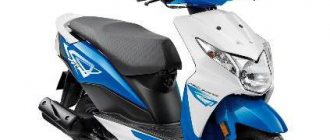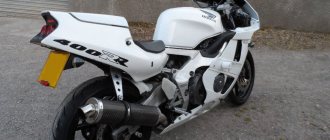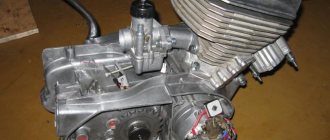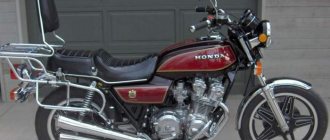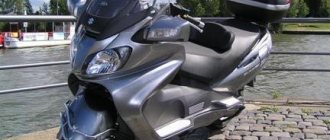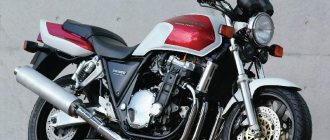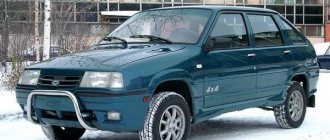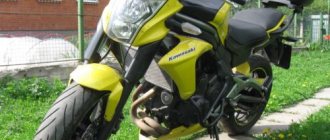| Honda Steed 400 (1988-1989) | Honda Steed 400 VLX (1990-1997) | Honda Steed 400 VCL (1995-1996) |
| Honda Steed 400 VSE | Honda Steed 400 VLS | Honda Steed 400 VLX (1998-2001) |
Honda Steed 400 cruiser model
appears on the Japanese market in 1988 in parallel with the older version of the Honda Steed 600. In the first years of production (until 1991), the model was in extremely low demand and there were even rumors that Honda was planning to end production of the motorcycle. However, by 1993, another boom in American-style motorcycles began in Japan, and the Steed 400 very quickly became a bestseller - within 10 years of production, the total number of Steed 400 and 600 sold reached 80,000 units.
Why did both versions exist at the same time? The fact is that in Japan, driver's licenses for motorcycles have different levels, depending on the driving experience. Thus, the Steed 400 could be used by any novice driver who had recently graduated from motorcycle school, while the Honda Steed 600 required a more advanced license.
The model was based on a 2-cylinder V-shaped liquid-cooled engine with a volume of 398 cm³, producing 30-31 hp. power and 32-33 Nm of torque. This engine was also installed on the Honda XL400V Transalp, Honda VRX 400, Honda Bros 400 and Honda Shadow 400 models.
Features of the Steed 400 include a classic steel duplex frame, front disc and rear drum brakes, simple suspension in the form of a conventional telescopic fork (VLS - springer) and a rear monoshock absorber, a 9-11 liter fuel tank (depending on the year and version), 5-speed gearbox and curb weight from 208 kg.
At first, there was only one modification of the Honda Steed 400 on the market (in addition, you could only choose a steering wheel - a curved or straight drag bar), which received the abbreviation VLX
(interpretation: V-Twin, Lowered, eXtended rake) - this is the designation of the standard version of the motorcycle.
In 1995, the model line was replenished with 2 modifications at once - VCL
(standby: V-Twin, Custom Limited) and
VSE
(standby: V-Twin, Special Edition).
The VCL
is a budget variant of the standard VLX, featuring the absence of a passenger backrest, a stock drag bar and a simpler saddle.
This version was 30,000 yen cheaper than the VLX. VSE
modification received a cast rear wheel in the style of Honda Magna and a curved steering wheel in stock. Both versions lasted until 1996, after which they were no longer offered.
In 1998, the Steed 400 line was replenished with a new modification - VLS
(decoding: V-Twin, Lowered, Springer front end). It features a unique style with a springer instead of a classic fork, a 21′ front wheel, a smaller fuel tank, ergonomics and overall dimensions. This version existed only during 1998.
2001 was the last year of production of the Honda Steed 400 model, which was slightly updated (added an exhaust afterburning system to comply with new environmental standards and other minor innovations) and finally rolled off the assembly line. In 1997, a new model, the Honda Shadow 400, was proposed as a successor to the Steed 400.
Main competitors in the class:
- Suzuki Intruder 400 / Suzuki LS400 Savage
- Kawasaki VN 400 Vulcan / Kawasaki EN400 Vulcan
- Yamaha XV400 Virago / Yamaha XVS 400 Drag Star
Brief history of the model
- 1988 - start of production and sales of the Honda Steed 400 model.
Model
: Honda Steed 400 VLX (Japan).
Frame number
: NC26-
100
XXXX~.
Factory designation
: NV400Cj.
- 1989 - no significant changes.
Model
: Honda Steed 400 VLX (Japan).
Frame number
: NC26-
105
XXXX~.
Factory designation
: NV400Ck.
- 1990 - The passenger backrest comes standard.
Model
: Honda Steed 400 VLX (Japan).
Frame number
: NC26-
110
XXXX~.
Factory designation
: NV400Cl.
- 1991 - model not produced.
- 1992 - no significant changes.
Model
: Honda Steed 400 VLX (Japan).
Frame number
: NC26-
115
XXXX~.
Factory designation
: NV400Cn.
- 1993 - fuel tank capacity increases from 9 to 11 liters.
Model
: Honda Steed 400 VLX (Japan).
Frame number
: NC26-
120
XXXX~.
Factory designation
: NV400Cp.
- 1994 - no significant changes.
Model
: Honda Steed 400 VLX (Japan).
Frame number
: NC26-
130
XXXX~.
Factory designation
: NV400Cr.
- 1995 - appearance of new modifications VCL and VSE. Starting this year, the model increases maximum power by 1 hp. and maximum torque by 1 Nm. The compression ratio is reduced from 10 to 9.8.
Model
: Honda Steed 400 VLX, Honda Steed 400 VCL, Honda Steed 400 VSE, Honda Steed 400 VSE (Japan).
Frame number
: NC26-
140
XXXX~ (VLX);
NC26- 139
XXXX~ (VCL);
NC26- 147
XXXX~ (VSE).
Factory designation
: NV400Ct; NV400CVs; NV400CMt.
- 1996 - no significant changes. The last year of release of the VCL and VSE modifications.
Model
: Honda Steed 400 VLX, Honda Steed 400 VCL, Honda Steed 400 VSE, Honda Steed 400 VSE (Japan).
Frame number
: NC26-
150
XXXX~ (VLX);
NC26- 144
XXXX~ (VCL);
NC26- 157
XXXX~ (VSE).
Factory designation
: NV400Cv; NV400CVt; NV400CMv.
- 1997 - model not produced.
- 1998 - appearance of the VLS modification. The standard VLX no longer has a stock passenger backrest and becomes a cross between the outgoing VLX and the budget VCL. The suspension settings are changed, the saddle height is reduced by 10 mm.
Model
: Honda Steed 400 VLX;
Honda Steed 400 VLS (Japan). Frame number
: NC26-
164
XXXX~ (VLX);
NC37-100-109
XXXX~ (VLS).
Factory designation
: NV400CBw; NV400CSw.
- 2001 is the last year of VLX production. The model receives an exhaust gas afterburning system and wiring for the installation of an alarm system.
Model
: Honda Steed 400 VLX (Japan).
Frame number
: NC26-
210
XXXX~, NC26-
211
XXXX~, NC26-
212
XXXX~.
Factory designation
: NV400CB1.
How to choose your first bike if you want a chopper?
The question of choosing your first motorcycle is always relevant. To date, thousands of publications have been written that describe hundreds of mots recommended for beginners. But only one of them was and remains the best. This is a Honda Steed 400 vlx. And it’s not just that its engine size is “forgiving of mistakes” with inexperienced driving.
It has enough power to be a biker's companion for many years. Repair and maintenance of the Honda Steed 400 is simple and inexpensive. This motorcycle is reliable and unpretentious. Change the oil and pads, fill it with gasoline, and it's always ready to go. But first things first.
Specifications
Technical characteristics of Honda Steed 400:
| Model | Honda Steed 400 |
| Motorcycle type | cruiser |
| Year of issue | 1988-2001 |
| Frame | steel tubular |
| engine's type | 2-cylinder, 4-stroke, V-shaped |
| Working volume | 398 cm³ |
| Bore/Stroke | 64.0 x 62.0 mm |
| Compression ratio | 10.0:1 - Steed 400, 1988-1995 9.8:1 - Steed 400, December 1995 to 2001 |
| Cooling | liquid |
| Number of valves per cylinder | SOHC, 3 valves per cylinder |
| Fuel supply system | carburetor, 2x Keihin 34 mm (VDD0) |
| Ignition type | transistor |
| Maximum power | 30.0 hp (22.0 kW) at 7500 rpm - Steed 400 (1988-1994) 31.0 hp (22.8 kW) at 7500 rpm – Steed 400 (1995-2001) |
| Maximum torque | 32.0 Nm (3.3 kg*m) at 5500 rpm – Steed 400 (1988-1994) 33.0 Nm (3.4 kg*m) / 5500 rpm – Steed 400 (1995-2000) 33.0 Nm (3.4 kg*m) / 6000 rpm – Steed 400 (2001) |
| Clutch | Multi-disc in oil bath, cable drive |
| Transmission | 5-speed |
| type of drive | chain |
| Front tire size | 100/90-19 57S 90/90-21 54S - VLS |
| Rear tire size | 170/80-15 77S |
| Front brakes | 1 disc, 296 mm, 2-piston caliper |
| Rear brakes | drum |
| Front suspension | telescopic fork - VLS |
| Rear suspension | pendulum with monoshock absorber |
| Motorcycle length | 2310 mm 2335 mm - VLS |
| Motorcycle width | 760 mm 705 mm – VLX with drag handlebar, VCL 865 mm – VSE 765 mm – VLS 890 mm – VLX (2001) |
| Motorcycle height | 1130 mm 1105 mm – VLX with drag handlebar, VCL 1120 mm – VSE, VLX (2001) 1115 mm – VLX (1998-2000), VLS |
| Wheelbase | 1600 mm 1620 mm – VLS |
| Seat height | 680 mm 670 mm - VLX (1998-2001) 650 mm - VLSD |
| Minimum ground clearance (clearance) | 140 mm 130 mm - VLX (1998-2001), VLS |
| Acceleration 0-100 km/h (0-60 mph) | 11.1 sec. |
| Maximum speed | 130 km/h |
| Gas tank capacity | 9.0 l – Steed 400 (1988-1992) 11.0 l – Steed 400 (1993-2001) 9.7 l - VLS |
| Motorcycle weight (dry) | 196 kg – Steed 400 (1988-1989) 199 kg – Steed 400 VLX (1990-1992) 201 kg – Steed 400 VLX (1993) 204 kg – Steed 400 VLX (1994-1997), VCL 203 kg – VSE, VLX (1998-2001) 211 kg – VLS |
| Motorcycle weight (curb) | 208 kg – Steed 400 (1988-1989) 211 kg – Steed 400 VLX (1990-1992) 214 kg – Steed 400 VLX (1993) 217 kg – Steed 400 VLX (1994-1997), VCL 216 kg – VSE 215 kg – VLX (1998-2001) 223 kg – VLS |
Appearance, character and a little history
This is a chopper whose appearance is not inferior to the legendary Harley. The low center of gravity gives the motorcycle stability. Sitting on it, the rider has a straight back. This fact makes the Honda Steed 400 a full-fledged representative of cruisers. The rider's legs are stretched forward and never become numb on long rides.
The Honda Steed 400 vlx was produced exclusively for the domestic Japanese market. There is also its brother, which is similar in appearance, and is called Honda Shadow. Despite all their similarities, they still differ and have design differences. A version with a 600cc engine was released for the American market.
But still, it was the Japanese four hundred that took the leading position in popularity among choppers. Here:
- V-shaped engine;
- abundance of chrome parts;
- wide rear wheel;
- characteristic landing;
- ideal proportions ensuring flawless contours.
All this is accompanied by outstanding technical characteristics. Let's talk about them.
Reviews
Reviews about Honda Steed 400:
Expand Collapse
It was bought by me after a short and very superficial viewing for 97 thousand. The set includes small arches and ears (they turned out to be a cool company), straight-through fish, and battered trunks and frames for them.
At first, the following problems emerged: the gasket under the antifreeze filler neck leaked (original 75r), the carbs required synchronization and cleaning, a weak charge was cured by restoring the wire in the generator-relay section. Dying rubber bands in the brake machine. Unfortunately, I’m putting off replacing it until I can drive like this.
For a beginner, I think this is a good motorcycle. The controls are clear and the seating position is comfortable. The dimensions are small, although it looks much larger than Viraga or Intruder. Low center of gravity. Forgives many mistakes.
Consumption is 4-5 Russian (if you come to a gas station on reserve, they can pour from 8 to 10 liters into a 9 liter tank.) liters in the city-highway. Comfortable speed is 100-110 km/h. Then the shaking begins (fingers then ring), deflation (maybe the glass solves the problem, but 400 cm is too heavy) and other delights of a small-volume chopper. By the way, I didn’t overclock it to more than 145, there seemed to be some reserve. Together (85kg+75kg) it goes up to 130 km/h, which is normal for the “itch” of this class.
In half a season I covered about 7000 km. I am almost completely satisfied with the motorcycle (weak engine). 400cc is already not enough and very often I feel like a vegetable, although for such a dynamic city as DS its motor is enough. If I were again choosing my first chopperoid up to 100 sput, I would take the steed again.
I skated on Steed for two seasons. Among the advantages, I would like to note its beauty, reliability (in 2 years it has never failed, it starts with half a turn, except for changing the oil - I did nothing at all), cork-permeability.
Among the minuses is a weak front brake (although if you use both the front and rear at the same time, you can slow down), a small saddle (although my big ass is more likely to blame for this), and 30 horses, which, together with the already mentioned part of the body, did not allow the conic to accelerate more than 120 km according to the speedometer. Although in the city, where the operation mainly took place, there were no complaints about the dynamics, in any case, you can stay in the flow without cranking the engine until it rings.
In general, I liked the mot and left the most pleasant memories. Good luck to him with his new owner!
Citizens, this is the perfect bike for the first season. The dry frame partly compensates for the low power of the engine, giving the output a light, passable car that can scoot perfectly both on the highway, without breaking out of the cruiser speed/comfort framework, and on country roads, demonstrating grip in low gears and stability on uneven roads, and even knead shit is no worse than the brainchild of the domestic motorcycle industry.
It makes sense to take a motorcycle if you have not yet decided whether you want to connect your life with two-wheelers. It is quite difficult to clean on the road, it is inexpensive and open to tuning. Another thing is that it is tuned quite rarely - rather than buying a 750 engine from Shadova for it and tuning it yourself, it’s easier to sell the Konik into good hands and buy a new one. Although, as a designer, Steed is very, very good. If desired, it can be equipped with spare parts from Junker, fenders and running boards from the Urals, cameras from Minsk, and even a Ural lever fork, which turns the kataka into a chic mess of avant-garde exterior.
In short, based on the results of the first season, the impressions are only positive. It's a pity to even give it away.
Comparative test drive of Honda Steed 400 and Suzuki Intruder 400
And, in fact, why not? I was recently told here that the world consists of more than just sportbikes, damn, who would have thought! Moreover, I confess, in my distant adolescence I had a dream, which, however, never came true... About a large, harsh motorcycle, always black, with an ornate horned steering wheel, with a “gynecologist’s appointment” seating position and with a male muffler, a dream any nymphomaniac. A reminder of the unfulfilled fantasy of a timid young man is the deadly heavy “leather jacket”, which occupies almost half of the entire closet, which, in an amicable way, would have been thrown out long ago, but the hand does not rise.
It’s just that at that time there were no such offers on the market, just as, in fact, there was no market itself for motorcycles used by fans of Pokemon and algae...
And now here it is. Do you want an almost exact copy of H.-D. Street Bob, and even with a lever-spring (parallelogram) front fork? Or maybe you prefer a clone of the H.-D modification. Fat Boy? At the same time, the budget should not exceed, well, say, 160,000 rubles? Please – Honda Steed 400VLC and Suzuki 400 Intruder Volusia are already waiting for their buyers. And while the latter is still wandering around somewhere, it’s time to try to understand what both of these motorcycles are. Looking with disbelief at the complex mechanism of the Honda front fork, I decided to give it to a colleague at first, and in return received a fat guy, bloated with self-importance - Suzuki 400 Intruder Volusia . It’s funny to sit almost on the ground, looking at the front wheel somewhere in front, but this is just a cost of permanent stay on sportbikes, a matter of time and habit.
Usually, after about two hours you begin to feel quite natural on almost any motorcycle, except that this does not apply to scooters. In this connection, it should be noted that there were absolutely no complaints about the ergonomics of both Honda and Suzuki . Despite the modest cubic capacity, both motorcycles were built quite “adult-style”. Everything is very serious - thick muffler pipes, wide donuts of rear tires, an inexperienced viewer will not have even a shadow of doubt that these are at least 1000 cc vehicles. It's no surprise that in this segment, 90% of market success depends solely on design.
So, we either have a classic version of a chopper with a narrow front wheel and a small donut at the back, respectively, Honda Steed , or we get a completely different type - in America it has a lot of different definitions - from “cruiser” to “classic motorcycle” (wow they are so “classic”, heh...).
For example, it seems to me that the “bobber” option is very suitable for the Suzuki Volusia Just don’t need hundreds of stones thrown into my garden - I know very well that this definition applies to other representatives of chopper-shaped animals, I just liked the word.
In terms of dynamics, both devices are approximately equal, up to 80 km/h there is some “movement”, which gradually fades away at around 120 km/h - it is not proper for the owners of such motorcycles to become like “plastic” ones rushing straight to hell. The higher gears here are quite “working”, but due to the small displacement of the engines, if you need any sudden acceleration or even ordinary “sluggish” overtaking, you won’t be able to “sit out” on them - you will have to push “down”. Although switching to third in both the Honda and Suzuki cases will not give the desired increase in acceleration - rather, the engine noise will simply increase, so fourth gear is more suitable for displaying “aggression” on both devices.
Traditionally, for such motorcycles, the space allocated for the passenger is rather arbitrary. But in our particular case, this does not apply to Suzuki - there is more than enough space for the “second number”. Another difference worth noting is the lower ground clearance of the Honda, which forces you to slow down almost to zero before every speed bump or just before ordinary bumps and wait with bated breath for the heartbreaking grinding sound under the sagging (that’s the idea) belly of the motorcycle.
Returning to the topic of size, it is important to note that the Suzuki Volusia, despite its 400cc format, is a full-size copy of its larger siblings. But on a Honda, people above average height may have certain problems, not so much with ergonomics (everything is in perfect order here), but with aesthetics, with the destruction of the image of a stern conqueror of long roads. The fact is that the average Russian, although he does not fall under the Hollywood template of a two-meter destroyer of decaliters of vodka, is still quite different in size from the one and a half meter Japanese, and in a jump and in a ski cap. In this connection, fairly large fellow citizens will look frankly comical at Honda; people are unlikely to be able to appreciate their subtle, aesthetic choice. Such gentlemen have a direct road to the Suzuki camp. All things being equal, the Volusia gives the feeling of being “more of a motorcycle.”
Now is the time to write about, in general, not the main part of the test in our case - that is, about dynamic indicators, in this category the priorities are set differently...
This is perhaps the rarest case when no noticeable effort was required from me to determine the leader. Both counterparts for quite a long time and sadly gain 130 km/h. Moreover, this is practically the limiting capabilities of the engines. Interestingly, if you are patient, both Honda and Suzuki can eventually demonstrate a “killer” 140 km/h. According to the speedometer... Thus, we can talk about a real maximum speed of 125–130 km/h. But, believe me, you will never want to do this, unless you are a test pilot for a motorcycle publication. Even out of idle curiosity. And the point here is not so much that in such modes both engines actually operate beyond their capabilities, although this is by no means an important factor. It just gets downright scary. The “rubber” chassis of both vehicles are not designed for such rates of movement. Honda and Suzuki are wagging their backs, living their own lives, trying in every possible way to reason with the “activist” who has lost his sense of smell, who has become somewhat overplayed as a tester and has finally left the image of a permanently beer-sipping biker. Imagine a marking line that usually runs along the dividing barrier on the Moscow Ring Road (however, not necessarily only there). So, on both the behemoth-shaped Suzuki and the graceful Honda, at the moment of its intersection, you feel with literally every vertebra exactly where and how many times first the front and then the rear wheel slipped, and how much this “terrible” obstacle caused the rear pendulum to bend along with the frame . If such warnings do not help, then both devices have a weapon that works 100% in such cases - brakes that were dead from birth. That's when it really gets scary! And don’t tell me that this is normal for choppers! I know a lot of other models of this class, where the brake mechanisms can easily give a head start to other sportbikes.
And if mediocre handling together with cargo dynamics (you still need to understand that we are talking about 400cc machines) can somehow be attributed to a feature of this class of motorcycles, then such sluggish brakes are already serious.
As for vibration load, both current duelists performed approximately equally well. In other words, up to the same, apparently textbook 80–90 km/h for choppers, everything is more than acceptable, but as soon as this value is exceeded, a few fillies begin to strain all their strength, in a vain attempt to show at least some speed. Naturally, nothing good comes of this, hence the vibrations. In general, as was noted at the very beginning of the article, you should look for happiness in dynamics on some other motorcycles. Here, in general, you need to be damn calm in character in order to start getting at least minimal pleasure. After all, even if you “puke” at the proper 90 km/h, there is always a big risk of getting a friendly blow to the tailbone, even on small bumps. And the point is not at all that the suspension is faulty, this is the price to pay for the peculiarities of the landing and its microscopic movement. However, things are noticeably more pleasant with the front fork. Moreover, oddly enough, the fashionable Honda mechanism showed itself to be much better than the classic Suzuki telescope with the thickness of the supporting pipes of such a small diameter that it seems that they can bend even from a slight wind.
The result is approximately the following picture. The Honda Steed is lighter and sleeker, especially when placed next to the somewhat overweight, slightly behemoth-like Suzuki. The price to pay for this is lower ground clearance than the competitor's and worse living conditions for the passenger. Also, the volume of the gas tank fell victim to beauty, which ultimately does not hold even 10 liters of fuel - with more or less active driving, repeated daily refueling is guaranteed. As a result, the motorcycle for travel is not the best, its habitat is the city, and its future owner should either be no taller than average height, or... a completely abstract individual indifferent to the opinions of others.
As a reward, he will receive a very stylish motorcycle, the front fork alone is worth it. As for the rather limited practicality - well, beauty has never been free... Suzuki Volusia seems to me like a strong middle peasant, albeit without the gloss of a Honda Steed, but with a normal-sized seat and a capacious gas tank. It is also important that on Suzuki there are no strict restrictions on the rider’s build. In general, there is nothing new in this world - beauty has always been far from mundane practicality...
Go to the Honda Steed 400
- Read review of Honda Steed 400
Check out the test drives:
- Test drive of the Honda Steed 400 motorcycle from Motorreview magazine
